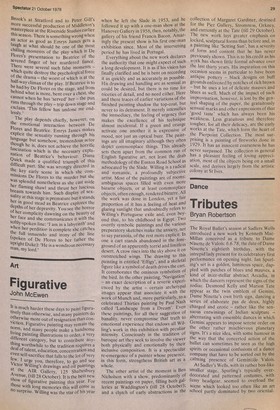Art
Figurative
John McEwen
It is much harder these days to paint figuratively than otherwise, and many painters do otherwise more out of resignation than conviction. Figurative painting may remain the norm, and many people make a handsome hying painting illustrations to order, a very different category, but to contribute anything worthwhile to the tradition requires a deal of talent, education, concentration and even self-sacrifice that falls to the lot of very few. . I urge you, therefore, to go and see Victor Willing's drawings and oil paintings at the AIR Gallery, 125 Shaftesbury Avenue, (till 28 October). It is the best new Show of figurative painting this year. For those with long memories this will come as no surprise. Willing was the star of his Year when he left the Slade in 1953, and he followed it up with a one-man show at the Hanover Gallery in 1956, then, notably, the gallery of his friend Francis Bacon. Amazingly the present show is his first one-man exhibition since. Most of the intervening period he has lived in Portugal. Everything about the new work declares the authority that one might expect of such a long development. It is as if his vision has finally clarified and he is bent on recording it as quickly and as accurately as possible. His drawing and handling are as sensual as could be desired, but there is no time for niceties of detail, and no need either. Here and there traces of earlier variations of the finished painting shadow the top-coat, but never to its detriment. It merely intensifies the immediacy, the feeling of urgency that makes the excellence of his technique almost incidental. If a green and orange activate one another it is expressive of mood, not just an optical buzz. The paintings are all imaginary although they often depict commonplace things. This already sets them apart from the common run of English figurative art, not least the drab methodology of the Euston Road School as advocated by the Slade. Willing is a radical and romantic, a profoundly subjective artist. Most of the paintings are of rooms: ambiguous spaces filled with even more bizarre objects, or at least commonplace objects, often enough, rendered bizarre. All the work was done in London, yet a fair proportion of it has a feeling of heat and glaring sunlight that undoubtedly refers to Willing's Portuguese exile and, even beyond that, to his childhood in Egypt. Two overtly symbolic paintings and the various preparatory sketches make the anxiety, not to say paranoia, of the rest more explicit. In one a cart stands abandoned in the foreground of an apparently torrid and limitless desert. A crow rises into the sky above it on outstretched wings. The drawing to this painting is entitled 'Effigy', and a skeletal figure like a symbol of death drives the cart. It corroborates the ominous symbolism of the bird. In the other painting, 'Navigation' — an exact description of a reverie experienced by the artist — certain archetypal images appear that associate it with the work of Munch and, more particularly, to a celebrated Thirties painting by Paul Nash called 'Landscape from a Dream'. Even these paintings, for all their suggestion of banality, never compromise that truth to emotional experience that endows all Willing's work in this exhibition with peculiar intensity. Consciously in the tradition of baroque art they seek to involve the viewer both physically and emotionally by their inclusive composition. It is a spectacular re-emergence of a painter whose presence, in this form, strengthens British art as a whole. The other artist of the moment is Ben Nicholson with a show, predominantly of recent paintings on paper, filling both galleries at Waddington's (till 28 October); and a clutch of early abstractions in the collection of Margaret Gardiner, destined for the Pier Gallery, Stromness, Orkney, and currently at the Tate (till 29 October). The new work lays greater emphasis on locked, sculptural forms than before and, in a painting like 'Setting Sun', has a severity of form and content that he has never previously shown. This is to his credit as his work has shown little formal advance over the last thirty years. His inspiration on this occasion seems in particular to have been antique pottery — black designs on buff grounds enlivened by notches of rich brown — but he uses a lot of delicate mauves and blues as well. Much of the impact of such improvisation, however, is lost by the genteel shaping of the paper, the gratuitously sensual marks and other expressions of that 'good taste' which has always been his weakness. Less gratuitous and therefore tougher, for all their delicacy, are the early works at the Tate, which form the heart of the Pierpoint Collection. The most surprising is a painting of fireworks done in 1929. It has an innocent coarseness he has never surpassed. The collection in general has a pleasant feeling of loving appreciation, most of the objects being on a small scale, and derives largely from the artistic colony at St Ives.






































 Previous page
Previous page